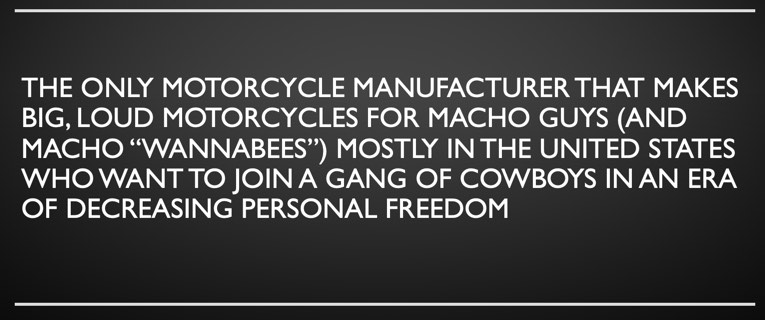“Are You Talking to The Right People?”
Make sure your message is right for the market...
You wouldn’t advertise underwear at a nudist camp, right?
A great salesperson can sell anything to anyone, right?
Let’s get the cliches out of the way right away… here’s a few examples:
- He could sell sawdust to a lumberyard.
- She could sell hay to a farmer.
- He could sell wood to a forest.
- She could sell a cape to Superman.
- He could sell crutches to a sprinter.
- She could sell a cage to a lion.
- He could sell ice to a polar bear.
- She could sell salt to a thirsty man.
This is relative to the topic today, because I’m going to prove to you that a GREAT salesperson NEVER sells someone something they don’t need.
In fact, if your message doesn’t match the actual market need with a real solution, expect at best one-time sales to customers who will never buy anything else from you again and at worst more refunds than you can handle.
Either way, your reputation is destroyed.
A great salesperson is a problem solver and a service provider.
A great business finds the problems in a market and creates solutions THAT group needs - desperately.
Once the problem is clarified and the solution is identified, the exact market with the desperate issue has to see the solution as not only an opportunity to fix a problem but a real Godsend.
When that happens, prospects come looking for you. And your business blows up.
So, What’s the problem?
Communication. It’s always communication.
Let’s look at an example. Read this brand message paragraph below. If you know anything about motorcycles, you have no doubt who this company is without naming the product.

But what’s the problem? Is it that we’re in an...
“Era of decreasing personal freedom”
Or that these are…
“Macho guys (and Macho ‘Wannabees’)”
Or that these guys want to…
“Join a gang of cowboys”
Look at it again.
In an era of decreasing personal freedom, these Macho guys (and Macho ‘Wannabees’) want to join a gang of cowboys…
That’s not really a problem. It’s a description of the symptoms of a problem.
In fact, the problem is more emotional than physical. By the way, it’s ALWAYS more emotional because a desperate problem causes some kind of pain, loss, or deprivation.
When describing the problem, it’s important to ask people suffering the problems a few questions:
- What does it feel like to experience that problem?
- When does the problem first appear?
- Does the problem cause you emotional pain or suffering? In what way?
- Do the people in your group have this problem? Does the group want a solution?
- How does the problem affect your livelihood, status, money or relationships?
- Does the problem seem desperate and/or hopeless?
- Would you pay for a solution to the problem?
Identifying the problem is difficult. We talk around it to get the feeling behind it.
Having been a Harley Davidson rider myself, the problem in our example is:
Men want something that makes them feel like men again.
There’s insecurity, longing for respect, more prestige and some serious mid-life crisis resolution going on.

But no company is ever going to advertise that they’re “The ONLY motorcycle manufacturer that makes big, loud motorcycles for men going through a midlife crisis.”
But that’s a heck of a market. Motivated men with discretionary money and enough insecurity to want a lot of power under their butts.
Of course, that is not stated explicitly in the brand copy but the message resonates with the buyers in the market!
Actually, it’s not even a hard sell.
If you get the message in front of the right market, the only thing left to do is pick out the color, check the motorcycle inventory and schedule a delivery date.
This works in any niche if you find a motivated buyer with a desperate problem that you can solve.
But the key is putting the right message in front of them.
Get that right, and a bad salesperson becomes a wealthy person.
Dan Kennedy, one of the most respected marketers in the world, said something like this (and I’m paraphrasing),
If you have the right message-to-market match, then your sales message doesn’t have to be that good to ‘work’. BUT if you have the WRONG message-to-market match, then the best sales letter in the world won’t work at all.
We’ve had a lot of success selling products to interested audiences.
And we’ve had our share of flops too.
When we send an email that gets little response, the issue is usually that the message didn’t resonate with that audience.
It didn’t match. In some way, it was incongruent.
Nothing kills marketing faster than incongruence.
A marketing relationship is like a date.
Having a rich, sumptuous dinner at a 5-star French bistro complete with a soulful jazz singer accompanied by a soft piano and a stand-up bass sets the tone for an elegant, relaxed, intimate evening.
Follow dessert with ring-side seats at a mixed martial arts slugfest with sweat, blood and god-knows-what-nastiness raining down on you seems a bit (maybe a ton) incongruent with your original message.
And probably spells the end of that relationship.
Incongruence is a jolt to the system.
It’s like walking on the beach in a snowstorm.
Or dogs smoking cigars and playing poker around a table piled with chips and cash.
The subtlest of inconsistencies can coat your message with a thick layer of what-the-heck-is-this? And if they have to ask that question, it will confuse your market to the point that they walk away.
A confused prospect will not buy anything.
So your brand message has to be congruent from the first word to the last. If there’s a hiccup along the way, you’ll lose the market.
To reinforce your brand message, tell stories
Stories help your audience remember your message clearly because they attach the emotion and images you create with a narrative.
A message without a story is just data.
Nothing cements a message in a prospect's brain like a story. And if you create a story around your message and deliver it to the right market, they will remember the story for years to come hanging on to your message all the while.
So, your assignment is to create a brand message that is clear and succinct. Then, wrap that message with an entertaining story that’s hard to forget.
I know what you’re thinking…
“I don’t know any stories.”
Of course, you do. You tell dozens of them every day. All you need is a little instruction on how to shape those stories into unforgettable tales that embed your brand message to leave a memorable impression on your market.
That’s why we’ve created our brand new Simple Story Selling course.
In part 1 of this 4-part course, we focus on using stories to communicate the brand message most effectively to drive sales and keep the pipeline full.
We break down these messages into a simple 6-part formula using the book Zag: The #1 Strategy of High Performing Brands.
And then, we find the right market that wants to hear your story.
But first, it starts with the brand message. And you can download a special fill-in-the-blanks template today to create your compelling brand message fast.
Download the template and pop your new brand message in the comments below.
That makes sense! Creating a brand is difficult at the start.